AMD Reveals Radeon Pro VII: A Workstation Card For When You Need It All
by Ryan Smith on May 13, 2020 10:15 AM EST- Posted in
- GPUs
- AMD
- Vega
- Radeon Pro

This morning AMD is taking the wraps off of a new high-end video card aimed at the workstation market, the Radeon Pro VII. True to its namesake, this is a professional version of the Radeon VII, which was first launched last year, incorporating AMD’s Vega 20 GPU and its full suite of pro-grade features. Taking the place at the top of AMD’s Radeon Pro stack of video cards, the Radeon Pro VII is aimed at AMD’s biggest workload customers in the CAD/CAM, media, and HPC workstation industries, who are willing to pay a premium for AMD’s fastest workstation card yet.
Like its namesake, the Radeon Pro VII is based on the company’s Vega 20 GPU, which when it launched in late 2018 was AMD’s first 7nm GPU. And though AMD is now on to their newer Navi architecture for graphics workloads, Vega 20 remains AMD’s single most powerful GPU to date. This is particularly evident in mixed graphics/compute or pure-compute workloads, where Vega 20’s unique features like fast double precision support, extreme memory bandwidth, and external Infinity Fabric links are not matched by any other card, and have become the backbone of AMD’s compute-focused Radeon Instinct MI50 and MI60 cards.
All told, AMD hasn’t produced a card like the Radeon Pro VII in quite some time. There have been numerous Radeon Pro cards over the last few years, but all of these were based on AMD’s more broad-market consumer and workstation GPUs. The Radeon Pro VII, by contrast, is AMD’s first professional card since 2014 that ticks all the boxes for both graphics and compute, offering significant rendering capabilities paired with the widest array of GPU compute features that AMD offers. In short, this is the card for workstation users who need it all, and they need it all in a single product.
| AMD Workstation Card Specification Comparison | ||||||
| Radeon Pro VII |
Radeon VII | Radeon Pro W5700 |
Radeon Pro WX 9100 |
|||
| CUs | 60 | 60 | 36 | 64 | ||
| ROPs | 64 | 64 | 64 | 64 | ||
| Boost Clock | ~1700MHz | 1750MHz | ~1930MHz | 1500MHz | ||
| Memory Clock | 2.0Gbps HBM2 | 2.0Gbps HBM2 | 14 Gbps GDDR6 | 1.89Gbps HBM2 | ||
| Memory Bus Width | 4096-bit | 4096-bit | 256-bit | 2048-bit | ||
| Single Precision | 13.1 TFLOPs | 13.8 TFLOPs | 8.89 TFLOPs | 12.3 TFLOPs | ||
| Double Precision | 6.5 TFLOPs (1/2 rate) |
3.5 TFLOPS (1/4 rate) |
556 GFLOPs (1/16 rate) |
769 GFLOPs (1/16 rate) |
||
| VRAM | 16GB | 16GB | 8GB | 16GB | ||
| ECC | Yes | Yes | No | Yes (DRAM) | ||
| TDP | 250W | 300W | 205W | <250W | ||
| GPU | Vega 20 | Vega 20 | Navi 10 | Vega 10 | ||
| Architecture | Vega (GCN 5) |
Vega (GCN 5) |
RDNA (1) | Vega (GCN 5) |
||
| Infinity Fabric Link | Yes (2x) | No | No | No | ||
| Manufacturing Process | TSMC 7nm | TSMC 7nm | TSMC 7nm | GloFo 14nm | ||
| Launch Date | 06/2020 | 02/2019 | 11/2019 | 10/2017 | ||
| Launch Price (MSRP) | $1899 | $699 | $799 | $2199 | ||
By the numbers, the Radeon Pro VII is a capable replacement for the Radeon Pro WX 9100 in AMD’s product stack. Similar to what we’ve seen there, AMD is swapping out older Vega 10 cards for newer and more powerful Vega 20 cards. The results from a performance perspective make the Radeon Pro VII the most powerful pro card in AMD’s arsenal, though the gains over the WX 9100 are a mixed bag.
With 60 active CUs and a boost clockspeed of roughly 1700MHz, on paper the Radeon Pro VII is not terribly faster in FP32 compute/graphics workloads than the WX 9100 it replaces; the clockspeed boost afforded by 7nm has been tempered somewhat by the lower CU count. Instead, what makes the Radeon Pro VII stand out is everything it can do that the WX 9100 could not, starting with double precision performance. Thanks to Vega 20, the card offers half-rate FP64 performance, giving it a peak throughput of 6.5 TFLOPs, over 8x that of the WX 9100, and almost 2x that of the consumer Radeon VII.
Backing the new pro card and its capabilities is a greatly enhanced memory controller backend. AMD has gone for a 4 stack HBM2 configuration, which with a memory clockspeed of 2Gbps/pin gives the card a total memory bandwidth of 1TB/second. This is more than double the bandwidth available on any other Radeon Pro card, and its why paper specifications only go so far. For extremely heavy workloads that will end up chewing up memory bandwidth – particularly anything pushing a lot of pixels – the Radeon Pro VII is much better equipped. And, of course, as a native feature of HBM2, it offers ECC memory protection.
The new card also comes with a couple of different and notable boosts to input/output options. First and foremost, the Radeon Pro VII comes with support for AMD’s external Infinity Fabric Link, which was first deployed in the Radeon Instinct MI50/MI60. The single connector along the top of the card provides for two IF links, offering a total of 168GB/sec of bandwidth (84GB/sec in each direction) between a pair of video cards. As with its Radeon Instinct implementation (and NVIDIA’s rival NVLink), the idea here is to allow both cards to more closely and efficiently work together for better multi-GPU performance, as well as for pooling the cards’ respective memory pools. This is accomplished by taking advantage of the better bandwidth and lower latency offered by IFLink, which is several times better than what PCI Express can provide. That said, because the technology is still relatively new for AMD’s GPUs, for graphics/rendering workloads it’s currently only supported with AMD’s ProRender 2.0 software.
Speaking of PCI Express, the Radeon Pro VII also ships with PCIe 4.0 support. Though not the first Pro card to get it – last year’s Radeon Pro W5700 technically wins that race – this is the first time that PCIe 4.0 support has been enabled in a high-end Pro card.
In fact, compared to the consumer Radeon VII, the Radeon VII Pro is in many respects a Radeon VII with all of the shackles thrown off. Features like PCIe 4.0 and fast FP64, which were restricted in the consumer card, are being made available for the first time in a workstation graphics card. This is what makes the Radeon Pro VII a jack of all trades within AMD’s product stack, as it offers all of AMD’s graphics features along with numerous compute and I/O features that previously were limited to their compute-focused Radeon Instinct cards.
With a full-featured Vega 20-based graphics card in hand, AMD is intending to chase the high-end of the workstation market with their latest hardware. This includes the CAD/CAM market, the media and broadcast market, as well as the market for HPC development. This collection of industries is a bit eclectic, but it reflects the markets and use cases where AMD believes the Radeon Pro VII’s unique features like fast FP64 support and IFLink will prove especially advantageous. Or to flip this argument on its head, these are the markets where more limited cards like the WX 9100 weren’t very well suited.
I suspect that the card will be especially welcomed by AMD’s compute customers, who up until now haven’t had a proper workstation version of Vega 20. In many cases HPC development is done locally with workstation cards, and then rolled out to larger servers and server clusters running numerous compute cards. Having identical hardware available locally makes it a lot easier to develop and optimize applications, so the Radeon Pro VII is well-suited to help HPC developers assemble programs for Radeon Instinct clusters, as well as the forthcoming El Capitan and Frontier supercomputers.
Meanwhile, in the broader competitive market the Radeon Pro VII will be going up against NVIDIA’s Quadro RTX cards. As is usually the case, AMD is focusing on their value proposition, not so subtly calling out the very high prices that NVIDIA charges for its Quadro cards. While the Radeon Pro VII has no perfect analog within NVIDIA’s product stack, the only card the company offers with quite the same mix of features – particularly FP64 performance – is their top-tier Quadro GV100. Otherwise, at an MSRP of $1899, the Radeon Pro VII is set to be cheaper than the Quadro RTX 8000, 6000, and 5000.
Overall, AMD should have little trouble delivering a better value; however the challenge for the company, as always, is convincing a conservative and slow-moving workstation graphics card market to switch to AMD. NVIDIA is well-entrenched here, and even though they’ve been significantly undercutting NVIDIA over the years, AMD has still needed to fight hard for workstation market share. The Radeon Pro VII, they hope, will help to finally break that logjam.
With all of that said, however, the timing of the Radeon Pro VII’s launch is particularly odd. AMD has been sitting on the basic hardware for quite a while now – the consumer Radeon VII went on sale over a year ago and has already been retired – so to launch a card now, so late into the current GPU technology cycle is rather unusual. Had AMD released this card a year ago, they could have enjoyed an extra year of sales before the competitive landscape significantly changed.
When I asked AMD about this odd timing, the response from the company was that the Radeon Pro VII launch is in response to professional customers using the consumer Radeon VII in workstations. Apparently the card was popular enough there to warrant AMD releasing a formal Pro version of the card, with all the bells and whistles like IFLink and fast FP64 turned on. While it’s not clear if this is from a broad range of requests or being driven by a small number of OEMs, I get the distinct impression that a Radeon Pro VII wasn’t originally in AMD’s product plans; in other words, it’s a launch being driven by customer demand.
Wrapping things up, the Radeon Pro VII will begin shipping in mid-June for $1899. Meanwhile, AMD’s OEM partners will begin shipping systems incorporating the card in the second half of the year.
Source: AMD


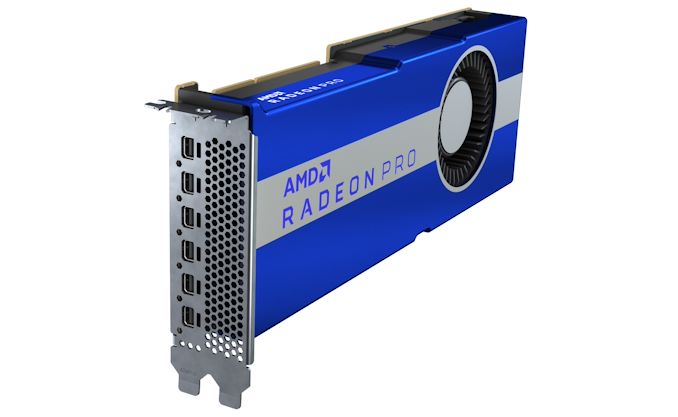
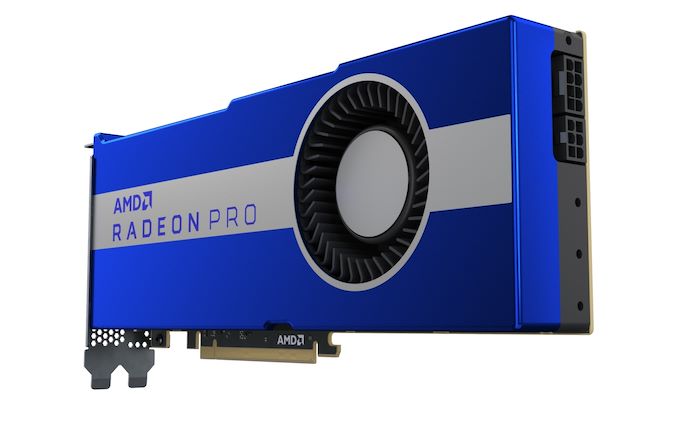







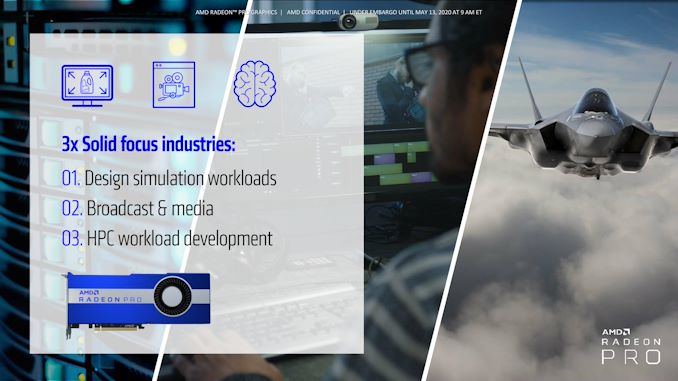
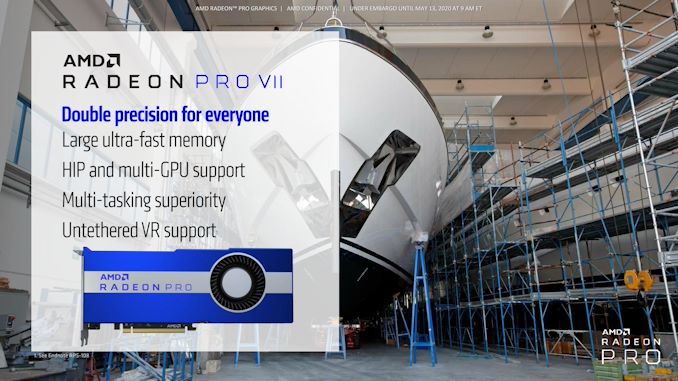
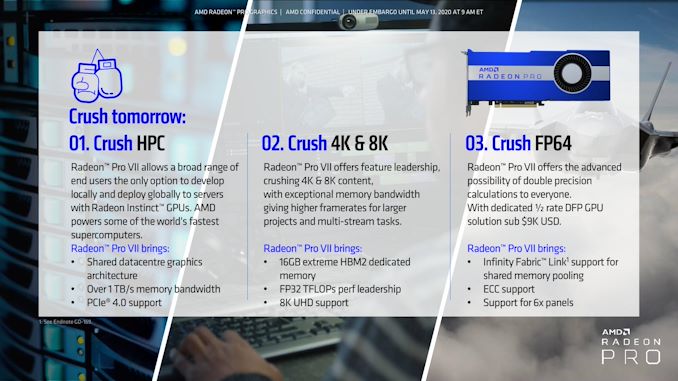
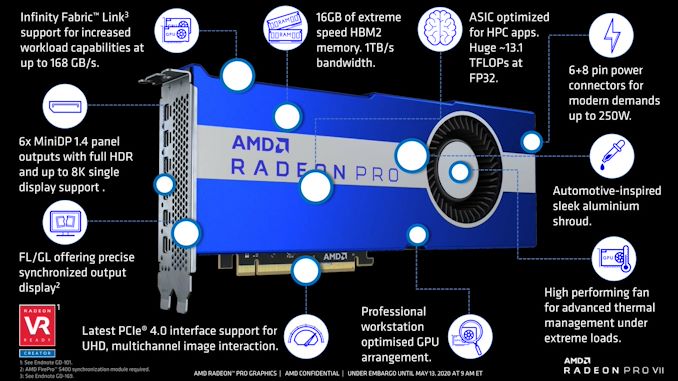














59 Comments
View All Comments
Ryan Smith - Wednesday, May 13, 2020 - link
Radeon ReLive for VR. It's something AMD has offered for a while. Piping the render output into their video encoder, and then from there back to the system. The only notable hardware it works with is HTC's enterprise-focused Vive Focus standalone headset.https://www.amd.com/en/technologies/radeon-softwar...
kobblestown - Wednesday, May 13, 2020 - link
I wonder if it suffers from the PCIe reset bug which prevents its use for GPU passthrough. AFAIK, all Vega cards have problems with this. It's a shame.hubick - Wednesday, May 13, 2020 - link
I stitch gigapixel panoramas and desperately want an 8K TV for viewing them, but I'm waiting for HDMI 2.1 or DP 2.0 on my PC before buying. This offering DP 1.4 w no HDMI, can you see the total disappointment on my face here AMD?hubick - Wednesday, May 13, 2020 - link
Also, 16GB of VRAM is so last year.Kevin G - Wednesday, May 13, 2020 - link
HDMI 2.1 barely on the market and capable 8K displays are so few and far between. With DSC, you could go even higher those single displays aren't out there yet.DP 2.0 has just got ratified so the first products for that are still a full year away.
DP 1.4 is the best you can reasonably expect right now and six of them still gets you plenty of pixels.
hubick - Wednesday, May 13, 2020 - link
Ampere will be announced tomorrow w HDMI 2.1 and DP 2.0. I'll buy one of those and choose between the many 2020 8K TV's w HDMI 2.1. There's no way to use DP 1.4 to drive an 8K TV at 60hz - you need HDMI 2.1 for that.Spunjji - Friday, May 15, 2020 - link
That's not true that there's "no way" - you can drive 8K at 60Hz over DP1.4, but it has to use DSC. Admittedly I haven't seen many products compatible with that, and a TV is especially unlikely to support it.Ampere's not really a fair comparison. It's not actually available yet and the display controllers will be 2 years newer.
mode_13h - Wednesday, May 13, 2020 - link
It was a foregone conclusion. This is a Vega 20 card, so it's not going to have any newer display outputs than Radeon VII had (which is built around a chip that first shipped in Nov 2018).Kevin G - Wednesday, May 13, 2020 - link
I'm kind of surprised that it took so long for this card to appear. The base Radeon Vega VII card appeared a full year ago. We know that AMD was still making these chips, at least in low volume, as they've had to supply Apple for the new Mac Pro.On the flip side, perhaps Crossfire performance leveraging Infinity Fabric resolves a lot of issues. I'd love to Crossfire virtualization so that two of these cards are seen by applications as one larger 120 CU (or 180, or 240 CU) card. Regardless and while I know it is a professional card, I'd love to see some gaming test using multiple GPUs with the Infinity Fabric link to how things have changed.
edzieba - Wednesday, May 13, 2020 - link
"With all of that said, however, the timing of the Radeon Pro VII’s launch is particularly odd."---
"Hehe, didya see that video Jensen put out? Laugh a minute that guy! How are our Pro VII sales doing, anyway"
"Our /what/ sales?"
"You know, the Pro VII. That card we launched last year"
"..."
"We did launch it, right? Just after the consumer one?"
"Nnnnnope"
"Oh no. OH NO!"